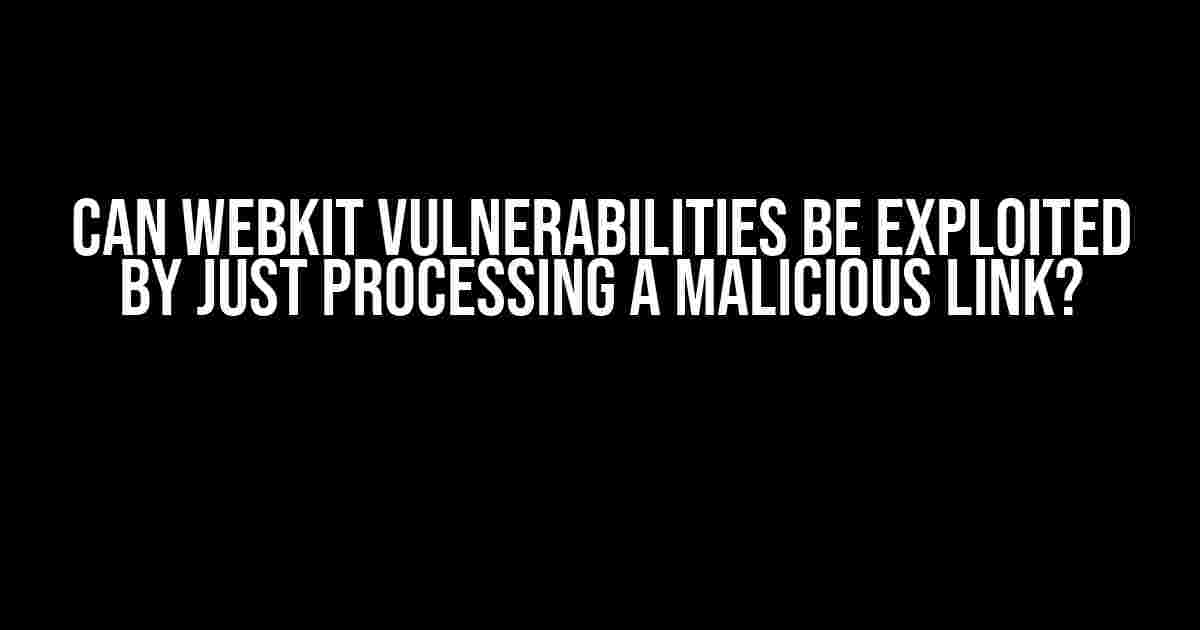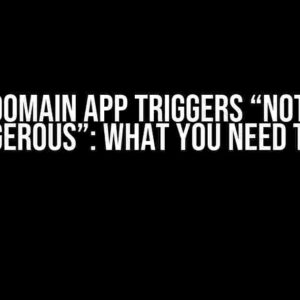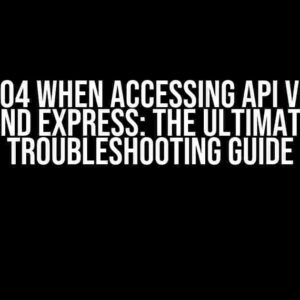As the web continues to evolve, so do the threats that come with it. One of the most critical components of modern web browsers is WebKit, an open-source rendering engine used by popular browsers like Safari and Google Chrome. While WebKit is designed to provide a seamless browsing experience, vulnerabilities in its code can be exploited by malicious actors, putting users’ sensitive information at risk. In this article, we’ll delve into the world of WebKit vulnerabilities and explore whether simply processing a malicious link can be enough to compromise your security.
What are WebKit vulnerabilities?
WebKit vulnerabilities refer to security weaknesses or flaws in the WebKit rendering engine that can be exploited by attackers to gain unauthorized access to sensitive information, execute malicious code, or take control of a user’s system. These vulnerabilities can arise from various sources, including:
- Buffer overflows or underflows
- Use-after-free flaws
- Memory corruption
- Improper input validation
- Outdated or unpatched software
When a WebKit vulnerability is discovered, it’s essential to patch it quickly to prevent exploitation. However, the process of patching and deployment can be time-consuming, leaving users vulnerable to attacks during the window of exposure.
How can WebKit vulnerabilities be exploited?
Exploiting WebKit vulnerabilities often involves manipulating the browser’s behavior through malicious input, such as:
- Malicious JavaScript code
- Crafted HTML or CSS content
- Specially designed images or multimedia files
- Exploited fonts or typography
Attackers can deliver these malicious inputs through various means, including:
- Phishing emails or instant messages with malicious links
- Infected websites or compromised web servers
- Malvertising or malicious advertisements
- Vulnerabilities in third-party plugins or extensions
Can WebKit vulnerabilities be exploited by just processing a malicious link?
The short answer is yes, but it’s not always that simple. WebKit vulnerabilities can be exploited by processing a malicious link, but the attack vector often requires a combination of factors, including:
- A vulnerable version of WebKit or a dependent component
- A specially crafted malicious link or payload
- A user interacting with the malicious link (e.g., clicking on it)
- A lack of security patches or updates
In some cases, simply processing a malicious link can be enough to trigger the exploitation of a WebKit vulnerability. This can happen when the link contains malicious JavaScript code or exploits a vulnerability in the way WebKit handles certain types of data.
However, in many cases, exploitation requires more than just processing a malicious link. Attackers may need to use social engineering tactics to trick users into interacting with the malicious content, such as clicking on a button or filling out a form.
Real-world examples of WebKit vulnerabilities
There have been several notable WebKit vulnerabilities in recent years that demonstrate the potential impact of these exploits. For example:
| Vulnerability | Description | Exploitation |
|---|---|---|
| CVE-2019-6237 | Use-after-free vulnerability in WebKit’s JavaScript engine | Exploited through malicious JavaScript code, allowing attackers to execute arbitrary code |
| CVE-2020-9790 | Buffer overflow vulnerability in WebKit’s WebAudio component | Exploited through crafted audio files, allowing attackers to execute arbitrary code |
| CVE-2020-13532 | Memory corruption vulnerability in WebKit’s WebRTC component | Exploited through malicious WebRTC peer connections, allowing attackers to execute arbitrary code |
These examples illustrate the potential severity of WebKit vulnerabilities and the importance of keeping your browser and its components up to date.
How to protect yourself from WebKit vulnerabilities
To minimize the risk of exploitation, follow these best practices:
-
Keep your browser and its components up to date:
sudo apt-get update && sudo apt-get upgrade(for Linux-based systems) -
Avoid interacting with suspicious links or attachments:
Be cautious when clicking on links from unknown sources, and never open attachments from untrusted senders.
-
Use strong antivirus software and a firewall:
Install reputable antivirus software and a firewall to help detect and block malicious activity.
-
Enable sandboxing and other security features:
Enable features like sandboxing, which can help contain exploits and prevent them from spreading to other parts of your system.
-
Use a reputable browser with a strong security track record:
Consider using a browser with a strong focus on security, such as Google Chrome or Mozilla Firefox.
-
Avoid using outdated or unsupported browsers:
Avoid using older browsers that may no longer receive security updates or patches.
To further protect yourself, consider implementing a defense-in-depth strategy that includes: * Regularly updating your operating system and other software * Implementing a robust backup strategy * Using a VPN (Virtual Private Network) when connected to public networks * Enabling two-factor authentication (2FA) whenever possible * Using a password manager to generate and store unique, complex passwords
Conclusion
WebKit vulnerabilities can be exploited by processing a malicious link, but the attack vector often requires a combination of factors. By understanding the risks and taking proactive steps to protect yourself, you can minimize the risk of exploitation and keep your sensitive information safe. Remember to stay vigilant, keep your browser and its components up to date, and avoid interacting with suspicious links or attachments.
Stay safe online!
Frequently Asked Question
Get the answers to your burning questions about WebKit vulnerabilities and malicious links!
Can simply visiting a website with a malicious link exploit WebKit vulnerabilities?
Yes, in some cases, just visiting a website with a malicious link can be enough to exploit WebKit vulnerabilities. This is because WebKit is used by many web browsers, including Safari and Edge, to render web pages. If a vulnerability exists in WebKit, a malicious actor can create a webpage that exploits that vulnerability, allowing them to gain unauthorized access or control over your system.
Do I need to click on the link or interact with the webpage in any way for the exploit to work?
Not necessarily. In some cases, simply loading the malicious webpage is enough to trigger the exploit. This is known as a “drive-by download” attack, where your browser is exploited simply by visiting a compromised website. However, in other cases, you may need to interact with the webpage in some way, such as clicking on a link or filling out a form, for the exploit to work.
Are all WebKit vulnerabilities exploitation-of-service (RCE) vulnerabilities, allowing attackers to execute arbitrary code?
No, not all WebKit vulnerabilities are RCE vulnerabilities. While some WebKit vulnerabilities can allow attackers to execute arbitrary code, others may allow for different types of attacks, such as cross-site scripting (XSS) or information disclosure. The severity and impact of a WebKit vulnerability depend on the specific vulnerability and how it is exploited.
Can I protect myself from WebKit vulnerabilities by using a different browser or disabling JavaScript?
Using a different browser or disabling JavaScript may not completely protect you from WebKit vulnerabilities. While WebKit is used by Safari and Edge, other browsers may also be affected by WebKit vulnerabilities. Additionally, disabling JavaScript may prevent some attacks, but it may not prevent all types of exploits. The best way to protect yourself is to keep your browser and operating system up to date with the latest security patches.
How can I stay safe from WebKit vulnerabilities when clicking on links from unknown sources?
To stay safe, it’s best to avoid clicking on links from unknown sources, especially if they are sent to you via email or chat. If you must click on a link, make sure your browser and operating system are up to date with the latest security patches. You should also use a reputable antivirus program and avoid using outdated or unsupported browsers. Finally, be cautious when clicking on links from unknown sources, and never enter sensitive information or login credentials on a webpage that you are unsure about.







